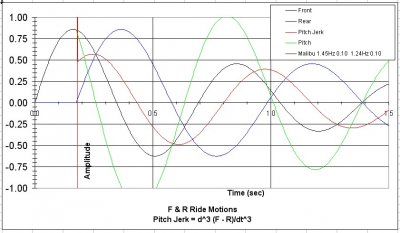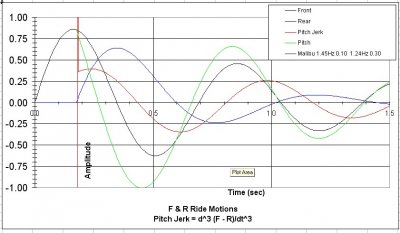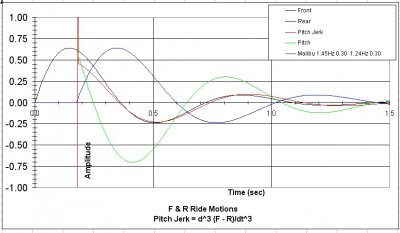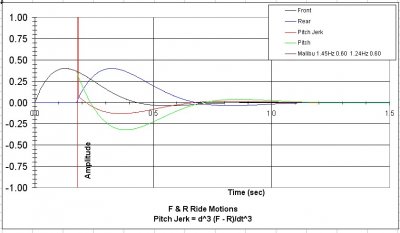Well, I worked out the formula for determining the proper rear spring rate for maintaining the "flat ride" that the stock suspension has, if given a desired new front spring rate. The formula is this:
The Brembo cars have 131 lbs/in front springs and 167 lbs/in rear springs. If I decided (for whatever reason, which can include experimentation) to go with the Boss 302 front springs, at 148 lbs/in, the above gets me a desired rear spring rate of 192 lbs/in. That just happens to be just 1 lb/in more than the rear spring rate of the Laguna Seca, and just 2 lbs/in shy of the rear spring rate on the 2012 GT500 SVT Performance Package.
But armed with the above, I should now be able to select spring rates for one end of the car that will maintain the front:rear ride quality characteristics of the stock suspension (or at least come close) while I vary the spring rate on the other end to suit my needs. So, for instance, if I wanted the front to be 250 lbs/in, I'd need to use 350 lbs/in springs in the rear to maintain the "flat ride".
The higher the front spring rate, the greater the rear:front spring proportion necessary to maintain the "flat ride". There probably comes a point at which the front:rear balance is so far off that it can't reasonably be compensated for with stabilizer bars for the purpose of maintaining a given understeer/oversteer characteristic. I haven't a clue where that point is.
Given my (limited, but useful) experience with coilovers thus far, it seems obvious that really good dampers can give me a very good ride even with relatively high spring rates, and with the above, I'll be able to maintain the ride characteristics I want as I ratchet up the spring rates.
This is going to be interesting! But first, I have to get some experience with the car in stock trim under my belt, to see how I like the car's current balance.
Knr = (1/(1/sqrt(Knf) - 1/sqrt(Kf) + 1/sqrt(Kr)))^2
where Kf is the current front spring rate, Kr is the current rear spring rate, Knf is the new front spring rate, and Knr is the new rear spring rate.
The Brembo cars have 131 lbs/in front springs and 167 lbs/in rear springs. If I decided (for whatever reason, which can include experimentation) to go with the Boss 302 front springs, at 148 lbs/in, the above gets me a desired rear spring rate of 192 lbs/in. That just happens to be just 1 lb/in more than the rear spring rate of the Laguna Seca, and just 2 lbs/in shy of the rear spring rate on the 2012 GT500 SVT Performance Package.
But armed with the above, I should now be able to select spring rates for one end of the car that will maintain the front:rear ride quality characteristics of the stock suspension (or at least come close) while I vary the spring rate on the other end to suit my needs. So, for instance, if I wanted the front to be 250 lbs/in, I'd need to use 350 lbs/in springs in the rear to maintain the "flat ride".
The higher the front spring rate, the greater the rear:front spring proportion necessary to maintain the "flat ride". There probably comes a point at which the front:rear balance is so far off that it can't reasonably be compensated for with stabilizer bars for the purpose of maintaining a given understeer/oversteer characteristic. I haven't a clue where that point is.
Given my (limited, but useful) experience with coilovers thus far, it seems obvious that really good dampers can give me a very good ride even with relatively high spring rates, and with the above, I'll be able to maintain the ride characteristics I want as I ratchet up the spring rates.
This is going to be interesting! But first, I have to get some experience with the car in stock trim under my belt, to see how I like the car's current balance.
Last edited:






